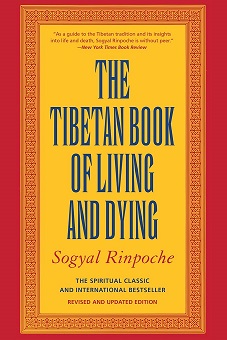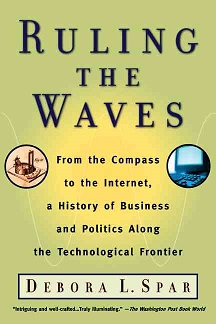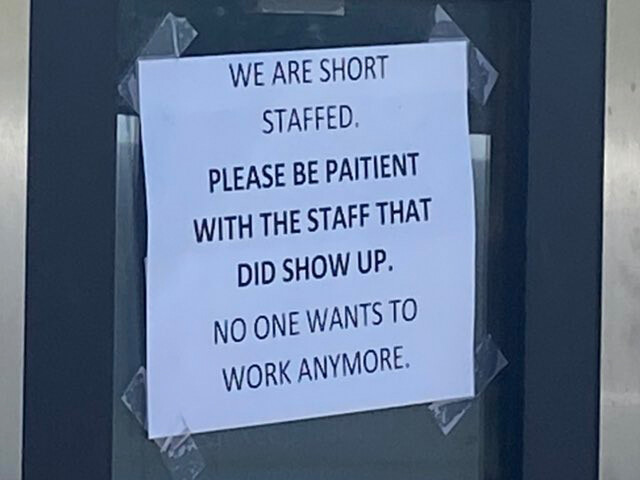Tibetan Buddhism Says: It’s All In The Mind
It comes up infrequently on this blog, but I am broadly interested in spiritual perspectives and metaphysics, and have a modest collection of books on religion and spiritualism which has fed my knowledge over the years. Of all the spiritual traditions I’ve read about, the one that resonates the most with me is Tibetan Buddhism. Buddhist philosophy in general is scientific, in that it is based on contemplative study, and is non-dogmatic. Tibetan Buddhism also happens to be the system that most closely aligns with the “science within consciousness” theories of my favorite philosopher, Amit Goswami.

So I was delighted when my partner showed up at home one day with a copy of “The Tibetan Book of Living and Dying,” which she had found at a thrift store. She’s always shopping at thrift stores and when she saw this book thought – correctly – that I would be interested in it. It was written by Sogyal Rinpoche, a Tibetan spiritual master who lived in exile in the West until his death in 2019. It’s essentially a layperson’s guide to The Tibetan Book of the Dead, which is an esoteric work that is difficult to understand (I know, I have a copy).
Here’s my review of the book on goodreads:
If you’ve ever tried to read “The Tibetan Book of the Dead” you know that it’s much too esoteric a work for the layperson. “The Tibetan Book of Living and Dying” makes the same teachings more accessible to the ordinary Western reader. The author is a Tibetan spiritual master who was living in exile in the West, and in his writing he adds a personal touch connecting the book to his autobiography and his experience as a spirtual practioner. At the heart of the Tibetan Buddhist teachings is recognition of impermanence and the need to prepare for death. This life is a transitionary stage only, a precious opportuntity to realize the true nature of reality, by encountering the true nature of the mind, the pure state of awareness called Rigpa. As the book puts it, “The View is the comprehension of the naked awareness, within which everything is contained.” (p. 156). This ties into the idea of primacy of consciousness, or monistic idealism, the metaphysical principle behind Tibetan Buddhist philosophy. The book goes into details of how to practice meditation and spiritual devotion, with emphasis on the power of compassion, but also the importance of finding a spiritual master. The book then goes into ways to help the dying. Western society does not connect death to spiritual growth, choosing instead to isolate the dying and prolong their suffering, which is a terrible approach (there is recognition in the book of how the hospice movement is changing this). There is also a detailed description, from the perspective of Tibetan Buddhism, of the process of dying, and of the experiences of the “bardos,” or transitionary states between death and rebirth. This is where the book ties into the more difficult to understand wisdom of the “Tibetan Book of the Dead”, which is poetic and ritualistic in format. This book explains the Tibetan beliefs and ritual practices in ordinary language. How much of it would be applicable to a Westerner in their life is another question, but certainly the overall philosophy and understanding of the meaning of life and death is valuable. The sincere and hopeful intention of the author, who was expelled from his suffering country at a young age, is heartwarming. This is a recommended work for anyone trying to decipher the “Tibetan Book of the Dead,” as well as for anyone looking for an insightful spiritual perspective on the nature and meaning of death.
Review of “The Tibetan Book of LIving and Dying” on goodreads.com.
What the Tibetan Book of the Dead is essentially doing is providing guidance on how to prepare for death, and on what to expect in the experience of dying. Part of this preparation is meditation, in order to train the mind to be still, to not grasp at thoughts and be troubled by turbulent emotion, so that you can experience awareness in its primal state. In that way, you will be prepared at death for encountering higher dimensions of the mind, and potentially becoming liberated. Buddhism focuses on the mind, because, as this post’s title suggests, the mind is the universal basis of experience, and all life and death occur within it.
Ideally you should be conscious and in a meditative state at the moment of death. If death is sudden and violent, or if you are in a troubled mental state while dying, these encounters with higher dimensions will pass by in a blip, and you will simply be propelled into a new incarnation. But if you are prepared, you will recognize these encounters, as described in the Tibetan Book of the Dead.
First, at the moment of death, you will encounter the Ground Luminosity, which is described by Sogyal Rinpoche as a self-originating clear light. It is the fundamental inherent nature of everything, which underlies all existence. It might even make sense to call it “the Supreme Being” – that is, that which is and beyond which nothing else is. You can see what I am getting at here. Should you recognize this Supreme Being and become One with it, then your karmic journey is complete. You’re done with it.
If not, you will next encounter what The Tibetan Book of Living and Dying calls the Intrinsic Radiance, which is like the mind in its purest state. You’re basically in a dream realm now. Within this radiance, the Peaceful and Wrathful Gods manifest, of which there are a large number, and which are all named and correspond to different aspects of the psyche. You might think of them as like Angels and Demons. You actually have a chance of remaining in this realm as an enlightened, disembodied being, but if not – off you go to your next birth.
I make the comparisons to similar concepts in Christian theology because I believe that all religious traditions derive from the same fundamental truths about the nature of reality. That’s why they end up with similarities in their models. Sogyal Rinpoche recognizes this too, and makes an explicit comparison between Buddhism and Christianity, when discussing the different mental realms in Buddhist philosophy.
These realms are the kayas, a word which literally means “body” but which signifies a dimension or field, according to Sogyal Rinpoche. They are the realm of the absolute, the realm of fullness without limitation, and the realm of the finite and relative. The experience at death is like a sudden ascent to the highest realm, followed by a descent into the realm of finitude, and incarnation.
This trinity of realms has a correspondence with concepts in Christianity, as follows.
| Dimension of the mind | Tibetan Buddhism | Christianity |
| dimension of unconditioned truth | Dharmakaya | Father |
| dimension of fullness, beyond duality, space and time | Sambhogakaya | Holy Ghost |
| dimension of ceaseless manifestation | Nirmanakaya | Son (Christ) |
Now to the parallels between what Sogyal Rinpoche writes and Amit Goswami’s science within consciousness. I hinted at them in the review with this statement:
As the book puts it, “The View is the comprehension of the naked awareness, within which everything is contained.” (p. 156). This ties into the idea of primacy of consciousness, or monistic idealism, the metaphysical principle behind Tibetan Buddhist philosophy.
What Goswami argues in his theories is that consciousness is the ground of being. Consciousness does not emerge from material interactions, as materialists would have you believe, but rather contains the material universe as a manifestation within it. As the Beatles put it, “it’s all within yourself.” This is similar to the Buddhist idea that all experience is within the mind.
Goswami’s argument for the primacy of consciousness is based on the measurement problem in quantum physics. The particle is not there unless it is observed, but if awareness were an epiphenomenon of material (i.e. particle) interactions, then how could observation manifest the particle? Awareness must be fundamental and the particles themselves the emergent phenomena.
In Goswami’s model, the ground of being is what he calls unitive consciousness – undifferentiated and universal. In the words of Erwin Schrödinger, “Consciousness is a singular of which the plural is unknown”. This unitive consciousness is like the Ground Luminosity, or the realm of Dharmakaya.
Consciousness must be unitive to avoid the “Wigner’s friend” paradox from quantum mechanics: how can two different observers collapse the same wave function? What if each observer collapsed it from its probabilistic wave form state into a different particle state? The Universe would be a mess!
Well, the answer is that there are not really two different observers. There is one field of awareness and one consciousness which chooses and manifests reality. The apparent separation of consciousness occurs because in the moment of observation, consciousness identifies with the measurement apparatus itself – that is, with the organism whose sensory systems are entangled in material reality. This creates a subject-object split – a subjective experience of an objective reality.
But really, both subject and object are aspects of the one field of consciousness, of the Absolute. The individuated self is a mirage. Everything, the experiencing self and all the objects it experiences, are encompassed in this one highest realm. As the Beatles put it, “life flows on within you and without you.” This is in concordance with the ideas of Tibetan Buddhism and other mystical traditions.
When unitive consciousness collapses the quantum wave function and manifests reality, there is at first an experience in “primary awareness.” This is akin to the experiences in the higher mental dimensions as described in The Tibetan Book of Living and Dying, and it is possible to directly access this experience though disciplined meditative practice. But ordinarily we experience reality in the “secondary awareness” of the ego, which gives us the familiar subjective sense of self and identity.
Goswami posits that, in addition to the material body which humans possess, we also possess subtle bodies whose forms determine our vital experiences and mental experiences – that is, our feelings and thoughts. The connection between our subtle bodies and our physical bodies is maintained through the entangled manifestation within consciousness. In the words of William Blake:
“Man has no Body distinct from his soul; for that called Body is a portion of a Soul discerned by the five senses, the chief inlets of Soul in this age.”
– William Blake, from The Marriage of Heaven and Hell
The physical and subtle bodies via which we experience reality are thus what we would call “Body and Soul,” and exist within the Sogyal Rinpoche’s dimension of Nirmanakaya, the realm of manifestation. But because our awareness emerges from a higher order, we are able to get a glimpse of higher realms. It is just difficult and not likely, especially if we allow ourselves to be distracted by all the goings on down here on Earth. That is precisely the point of mystical wisdom such as that of The Tibetan Book of the Dead: to teach us about this potential and remind us of its importance, given that our time in the world of manifestation must inevitably come to an end.
Sogyal Rinpoche doesn’t know about Goswami (The Tibetan Book of Living and Dying came out well before Goswami’s publications), but he does bring up one physicist whose theories connect to Tibetan Buddhism. That physicist is David Bohm, whose ontology of an implicate order and an explicate order to explain the mysteries of quantum physics can be likened to the different realms of mental experience which Sogyal Rinpoche describes. This correspondence is given in The Tibetan Book of Living and Dying, and I’ll just add to it here, from Goswami’s model.
| Realm | David Bohm | Amit Goswami |
| Dharmakaya | superimplicate order | The bliss body of unitive consciousness |
| Samboghakaya | implicate, enfolded order | The formless body in the archetypal realm |
| Nirmanakaya | explicate, unfolded order | The limited body of experience in the realm of manifestation |
I hope this introduction to spiritual science has been illuminating. It’s a subject which has intrigued me for a long time, though I tend to study it more from an intellectual perspective than as spiritual practitioner. I know I should meditate more, but the world of manifestation is always beguiling me with its fascinating goings on.
Here is the wisdom of the Beatles to close off this post. May you see beyond yourself and find peace of mind!


